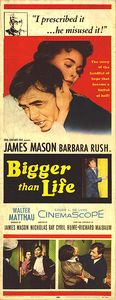 After watching Bigger than Life in all of its glorious, controlled, expansive, vibrant, claustrophobic, screaming Cinemascope glory I watched it again.
After watching Bigger than Life in all of its glorious, controlled, expansive, vibrant, claustrophobic, screaming Cinemascope glory I watched it again.
But this time I watched it without sound, and let Nic Ray’s framing, colors, and movement take over the storytelling. Even without James Mason’s frightening performance as the suburban father slowly losing his grip on the frameworks of his life, the film remains a delirious fever dream of longing, entrapment, angst and addiction.
It is easiest to look at this film through the lens of Ray’s film of just a year prior—Rebel Without a Cause. In that film, another family is forced to confront the fact that the nuclear family bond is violent, nurturing, magnetic and repulsive. Whereas in that tale we find James Dean begging his father for some direction, here we have James Mason providing perhaps too much. And so the roles of Rebel are somewhat reversed. We do not see the Avery boy really looking for answers, but Ed Avery is no apron-wearing wimp. He is devastating to see, turning math problems and games of catch into stark life lessons about manhood and disappointment.
In one such scene, as Ed Avery surely has slipped into some sort of madness, he drills his young son with math lessons, way past dinner time—his mother trying to keep a straight face in light of her husband’s dominance. Having slipped the boy a small glass of milk to keep him going, she retreats to the table to await the completion of the lesson. We cheer at her small victory, having fed the child while the monster is away for just a moment. But as Ray’s frame reveals once they are seated at the table, every move leaves a mark behind. This time, it is the remnants of the milk, still clinging to the sides of the glass pitcher. A small victory turns into yet another opportunity for Ed Avery to burn.
Why does the burning man burn? This question, posed by B. Kite, author of the liner notes in this new DVD release, is in response to Ray’s original treatment for Bigger than Life, in which a man, aflame, runs down the street until he is smothered and extinguished—all while a horrified child looks on. Why indeed. Though this opening was never used, the question remains fluid and unanswerable. Was it Suburban angst, fifties conformity, nuclear family control? Or is it just the cortisone? The beauty of Ray’s portrait and Mason’s performance is precisely its malleability. In the structured frame there is a man bursting at the seams, aflame, his gasps of rage terrifying his family and us. The final moments, then, give us little relief. As Ed Avery pulls his family closer, closer, whispering, “Tighter…tighter.” We only wonder if he is tightening the coil yet again.
-Rob Ribera